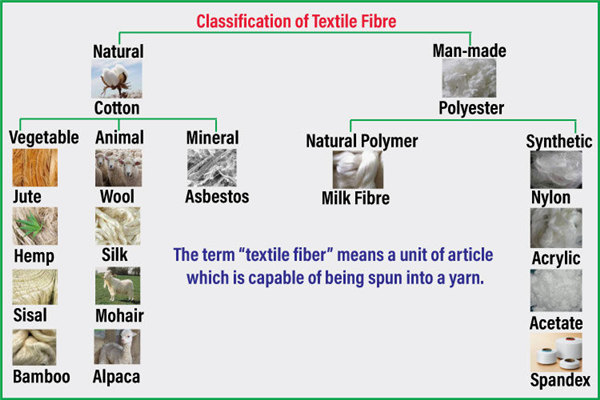Fibres are the basic elements of textiles. Generally speaking, materials with diameters ranging from several microns to tens of microns and with lenghts being many times of their thickness can be considered to be fibres. Among them, those longer than tens of millimetres with sufficient strength and flexibility can be classified as textile fibres, which can be used to produce yarns, cords and fabrics.
There are many types of textile fibres. However all may be classified as either natural fibres or man-made fibres.
1. Natural Fibres
Natural fibres include plant or vegetable fibres, animal fibres and mineral fibres.
In terms of popularity, cotton is the most commonly used fibre, followed by linen ( flax ) and ramie. Flax fibres are commonly used, but since the fibre length of flax is fairly short (25~40 mm) , flxa fibres have traditionally been blended with cotton or polyester. Ramie, the so-called "China grass", is a durable bast fibre with a silky lustre. It is extremely absorbent but the fabrics made from it crease and wrinkle easily, so ramie is often blended with synthetic fibres.
Animal fibres either come from the animal's hair, for example, wool, cashmere, mohair, camel hair and rabbit hair, etc., or from the animal gland secretion, such as mulberry silk and tussah.
The most commonly known natural mineral fibre is asbestos, which is an inorganic fibre with very good flame resistance but is also dangerous to health and, therefore, is not used now.
2. Man-made Fibres
Man-made fibres can be classified as either organic or inorganic fibres. The former can be sub-classified into two types: one type includes those made by transformation of natural polymers to produce regenerated fibres as they are sometimes called, and the other type is made from synthetic polymers to produce synthetic filaments or fibres.
Commonly used regenerated fibres are Cupro fibres ( CUP, cellulose fibres obtained by the cuprammonium process) and Viscose ( CV, cellulose fibres obtained by the viscose process. Both Cupro and Viscose can be called rayon). Acetate ( CA, cellulose acetate fibres in which less than 92%, but at least 74%, of the hydroxyl groups are acetylated.) and triacetate (CTA, cellulose acetate fibres in which at least 92% of the hydroxyl groups are acetylated.) are other types of regenerated fibres. Lyocell ( CLY ), Modal ( CMD ) and Tencel are now popular regenerated cellulose fibres, which were developed to meet the demand for environmental consideration in their production.
Nowadays regenerated protein fibres are also becoming popular. Among these are soyabean fibres, milk fibres and Chitosan fibres. Regenerated protein fibres are particularly suited for medical applications.
Synthetic fibres used in textiles are generally made from coal, petroleum or natural gas, from which the monomers are polymerized through different chemical reationd to become high molecular polymers with relatively simple chemical structures, which can be melted or dissolved in suitable solvents. Commonly used synthetic fibres are polyester ( PES ), polyamide ( PA ) or Nylon, polyethylene ( PE ), acrylic ( PAN ), modacrylic ( MAC ), polyamide ( PA ) and polyurethane ( PU ). The aromatic polyesters such as polytrimethylene terephthalate ( PTT ), polyethylene terephthalate ( PET ) and polybutylene terephthalate ( PBT ) are also becoming popular. In addition to these, many synthetic fibres with special properties have been developed, of which Nomex, Kevlar and Spectra fibres are will known. Both Nomex and Kevlar aer the registered brand names of the Dupont Company. Nomex is a meta-aramid fibre with an excellent flame retardant property and Kevlar can be used to make bullet-proof vests because of its extraordinary strength. Spectra fibre is made from polyethylene, with ultra-high molecular weight, and is considered to be one of the strongest and lightest fibres in the world. It is particularly suited for armour, aerospace and high-performance sports good. Research is still going on. The research on nano fibres is one of the hottest topics in this field and in order to ensure that nanoparticles are safe for mand and the environment, a new field of science called "nanotoxicology" is derived, which currently looks at developing test methods for investigating and evaluating the interaction between nanoparticles, man and environment.
Commonly used inorganic man-made fibres are carbon fibres, ceramic fibres, glass fibres and metal fibres. They are mostly used for some special purposes in order to perform some special functions.
Thanks for your time.
Post time: Mar-20-2023

